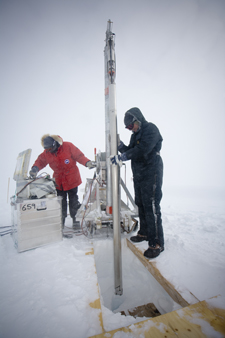Prestigious EU Grant for Climate Research at the Niels Bohr Institute
Center for Ice and Climate at the Niels Bohr Institute, the Danish Meteorological Institute (DMI) and the Bjerknes Center in Norway has received a shared grant of approx.12.500.000 Euro (90 mill. Danish Crowns) for Arctic climate research focusing on abrupt climate change and consequences of such change for the Greenland ice sheet. It is an ERC Synergy grant, which is intended to enable research groups from different research fields and institutions in Europe to bring together complementary skills, knowledge, and resources in new ways, in order to jointly address research problems.

During the past 35 years the permanent Arctic sea ice cover has been reduced in extent by some 30-50%. The Ice2Ice research project will focus on the influence of the Arctic sea ice on climatic conditions in the Arctic and the mass balance of the Greenland ice sheet.
"The Ice2Ice research project will focus on the influence of the Arctic sea ice on climatic conditions in the Arctic and the mass balance of the Greenland ice sheet. From Greenland ice core records we know that climatic conditions in Greenland could change dramatically within a few years during the last ice age. From sea sediment cores we can see, that these changes were intimately related to changes in sea ice extent during this period", explains ice core researcher Bo Møllesøe Vinther, principal investigator of the Ice2Ice project at Center for Ice and Climate, Niels Bohr Institute at University of Copenhagen.
Interdisciplinary project
Research activities in Ice2Ice are carried out in four teams where scientists will drill and analyze Eastern Greenland ice cores, collect new ocean sediment cores near the Greenland east coast, make detailed model simulations of Greenland climate and ice sheet conditions and study the stability of the Arctic sea ice cover. All this will be done to uncover the mechanisms behind sudden changes in the sea ice and to understand past abrupt climate change in the Arctic.
Will Arctic sea ice suddenly vanish?

As part of the Ice2Ice project the Centre for Ice and Climate will drill a number of shallow cores in Eastern Greenland. The climate of Eastern Greenland is greatly affected by the Arctic sea ice export along the Greenland east coast. Hence the new ice cores will be important for reconstructing the history of Arctic sea ice variability; a cornerstone in Ice2Ice. (Credit: Christian Morel)
The fundamental questions Ice2Ice will seek to answer is whether the abrupt climate changes that coincided with abrupt sea ice loss during the last glacial period will be repeated in the future. During the past 35 years the permanent Arctic sea ice cover has been reduced in extent by some 30-50%.
Will global warming cause this gradual decline of the sea ice to continue or will the Arctic suddenly reach a point where the sea ice cover abruptly disappears? The answer to that question is important for climatic conditions in most of the northern hemisphere and absolutely crucial for any predictions concerning the future of the Greenland ice sheet – another key issue addressed by Ice2Ice.
European prestige
“All of us are delighted that we will now have the possibility to investigate some of the big unanswered questions within the field of climate research: What are the mechanisms behind abrupt climate change during the glacial period? Can such abrupt changes happen in the future? And what will the impact be on the vast Greenland ice sheet?” states Bo Møllesøe Vinther.
The fact that the Ice2Ice proposal succeeded to obtain funding from Synergy Grants at the European Research Council is a significant mile stone for Danish research. No applications from neither Norway nor Denmark have been successful before. The Niels Bohr Institute part of the grant will be around 30 million Danish Crowns over five years.
